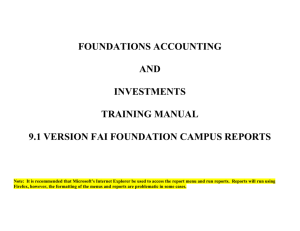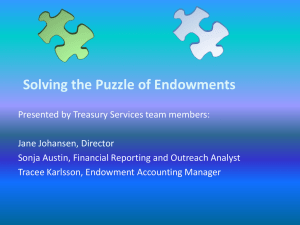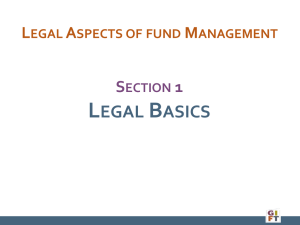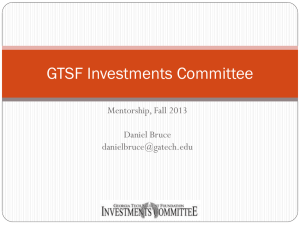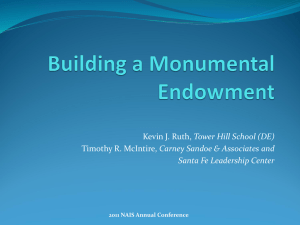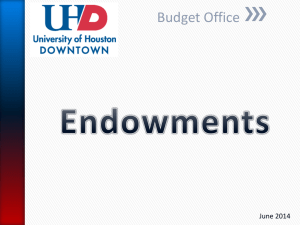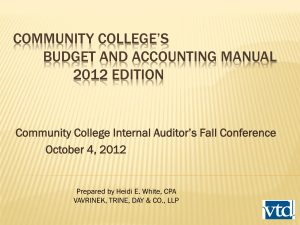Endowment Accounting
advertisement
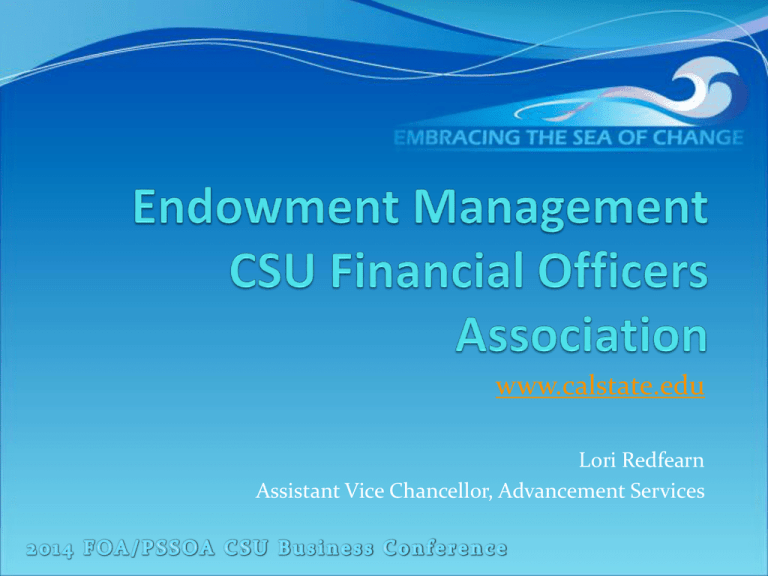
www.calstate.edu Lori Redfearn Assistant Vice Chancellor, Advancement Services CSU Endowment Market Value New Gifts to Endowment Annual Investment Return Corpus & PY Inv't Return Distribution $1.02 B $1.03 B $1,024 $1.18 B 2010/11 2011/12 2012/13 $55 $197 $805 -$32 $46 -$12 $1,035 -$42 $62 $130 $1,027 -$37 Endowment Asset Range Profile Campus Count $1.18 B $485 M $347 M $157 M $192 M $192 >$100 M 3 $142 M - $184 M >$50 M to $100 M 5 $50.5 M - $99 M >$25 M to $50 M 4 $29 M - $48 M <$25 M 12 $5 M - $24 M Uniform Prudent Management of Institutional Funds Act (UPMIFA) Effective January 1, 2009 Applies prudence standard to investing and spending Eliminates concept of historic dollar value Rules for releasing or modifying endowment terms Considerations of Prudent Investing Effects of inflation Investment decisions must be made in relation to overall resources of the institution and its charitable purposes. No investment decision may be made in isolation, but in light of the fund’s entire portfolio. Investment should be part of a strategy “having risk and return objectives reasonably suited to the fund and the institution.” Diversify assets as an affirmative obligation unless “special circumstances” dictate otherwise. 2013 Endowment Asset Allocation 36.01% 27.12% Domestic Equities Fixed Income Int'l Equities Alt. Strategies Cash/Other 3.27% 16.47% 17.13% Endowment Performance Dollar Weighted Average Investment Return Endowment Assets 2010/11 2011/12 2012/13 > $100 M 16.02% -0.67% 10.9% > $50 M to ≤ $100 M 20.73% -0.94% 11.3% > $25 M to ≤ $50 M 20.45% -2.45% 7.3% Less than or = $25 M 19.38% -1.65% 11.3% Total Market Value $1,024 M $1,026 M $1,181 M • Net of Management Fees and Expenses • CSU Median Return =10.93% • 2012/13 Industry Benchmark: Russell 3000 65% and Barclay's Aggregate Bond Index 35% = 12.44% Peer Comparison Endowment Assets CSU NACUBO Variance > $101 M to ≤ $500 M 10.9% 11.9% -1.0% > $51 M to ≤ $100 M 11.3% 11.6% -0.3% > $25 M to ≤ $50 M 7.3% 11.4% -4.1% Less than or = $25 M 11.3% 11.6% -0.3% • Net of Management Fees and Expenses • CSU Average Return = 10.99%; Median Return = 10.93% • NACUBO Average Return = 11.7%; Median Return = 11.7% Considerations of Prudent Spending Seven criteria guide board spending decisions: 1. Duration and preservation of the endowment fund 2. Purposes of the institution and the endowment fund 3. General economic conditions 4. Effect of inflation or deflation 5. Expected total return from income and the appreciation of investments 6. Other resources of the institution 7. Investment policy of the institution Spending Policies Moving Average Over Rate Flat 12 Qtrs 3.00% 16 Qtrs 20 Qtrs 1 1 3 Yrs Mix 3 1 3.50% 4.00% 2 4.25% 4 1 1 4.50% 5.00% Other: 2 1 1 1 • (3) Decide on an appropriate rate or amount each year • (1) Spend all current income • (1) Weighted average or hybrid method Spending Compared to Investment Returns 14% 12% 10% 8% 6% 4% 2% 0% 3 Yr Ave Inv't Return 2012/13 Spending Rate Modification Rules A donor may release or amend a restriction. A court may modify a restriction in accordance with the donor’s probable intention. The Attorney General must be notified. A charity may modify a restriction on a small (<$100,000) and old (>20 years old) fund without going to court. If the restriction becomes unlawful, wasteful, or impracticable to achieve. Use must be consistent with donor intent. The Attorney General must be notified. Questions? Sheralin Klinthong Associate Director, Financial Reporting and Review Endowment - Overview An endowment is a transfer of money and/or property donated with the intention to support the University and its auxiliary organizations in perpetuity or during a stipulated term. Based on Ed code 89721, endowment funds received by the university should be deposited in California State University Trust fund (0948-466). CSU Fund 921 is available for auxiliary organizations to record endowment funds. Endowments may come with stipulations regarding its use (by donor or governing board). Endowment funds can be unrestricted or restricted. Endowment Investment as June 30, 2013 CSU Aux Org Most endowment in the CSU are held by the auxiliaries (usually foundations) to maximize the return on endowment investments and for other considerations. Sources of Endowment Balance Original Gift Net Appreciation (realized and unrealized) Interest/Dividends Types of Endowment Funds Source of Funds Time Requirement Use of Funds External Donor Permanent Unrestricted Governing Board (quasi endowment) Term Restricted True Endowment Definition Established when the donor states that the gift is to be held permanently as an endowment as identified in a written gift agreement or the organization restricts it for specific use as solicited from donors. The original funds and any additional principal cannot be withdrawn, expended, or otherwise exhausted. FASB Fund is classified as Permanently restricted net assets GASB Also referred to as Permanent Endowment. Fund is classified as Restricted nonexpendable net position Term Endowment Definition Funds set aside for a specific period of time or until occurrence of a certain event. These funds can be established by a donor or the organization. FASB Fund is classified as Temporarily restricted net assets GASB Fund is classified as Restricted expendable net position Quasi Endowment Definition Funds set aside by an organization’s governing board, which maintains the power to release the restriction on principal spending. Additional reserve funds, and other unrestricted gifts are often used to set up this fund type. The Funds are held by board resolution and therefore can have policies and procedures that allow withdrawal of principal. Also referred as BoardDesignated Funds. FASB Fund is classified as Unrestricted net assets GASB Fund is classified as Unrestricted net position GASB Example: Permanent Endowment Facts: A corporation gives $5 million to a state university (recipient) with the stipulation that the university establish an endowment, invest the gift, and maintain the principal intact in perpetuity. The investment income is to be used for scholarships for underprivileged students majoring in business or public administration. Type: Permanent endowment (permanently nonexpendable addition to net position). Restrictions: Purpose restriction - the requirement to invest the gift and use of investment income for specified purposes Time restriction - the stipulation that the principal be maintained intact in perpetuity (can never be expended) Accounting: recognize assets and revenues when the gift is received because at that time the university begins to comply with the time requirement (to maintain the principal intact). The university should always report resulting net position or fund balance (principal) as restricted because of the purpose restriction and the time requirement (investment in perpetuity). GASB Example: Term Endowment Facts: An alumnus promises to donate $500,000 to his alma mater with the stipulation that the university invest the principal and use the income to provide summer research grants for accounting faculty members. The terms of the agreement specify that, after the donor’s death, the university should withdraw the principal of the gift and use (expend) it, also for summer research grants for accounting faculty members. Type: Term endowment Restrictions: Purpose restriction - requirements to invest the principal until the donor’s death and then to expend it for summer grants Time restriction - requirement to maintain the principal intact until after the donor’s death Accounting: The university should recognize assets and revenues when the gift is received. It should not recognize a receivable when the promise is made because it cannot begin to comply with the time requirement until the gift is received. When the gift is recognized, the university should report resulting net position or fund balance as restricted because of the purpose restrictions and the time requirement. However, it should continue to report net position or fund balance as restricted after the donor’s death, until the principal is expended in accordance with the donor’s stipulations. Investment in Land and other Real Estate Held by Endowments (GASB) GASB 52 requires that land and other real estate held by endowments (except federal land grants) be reported at fair value at the reporting date. Any changes in fair value during the period should be reported as endowment income. Significant assumptions used to determine fair value should be disclosed as required by GASB 31. Underwater Endowment Definition Underwater endowment occurs when the value of donor-restricted endowment funds decline below the corpus. Consideration of various accounting issues is required. GASB Reduction of Restricted net position is ALLOWED. If liabilities that relate to specific restricted assets exceed those assets, no restricted component net position should be reported – the net negative amount should reduce unrestricted net position. FASB Permanently restricted net assets is NOT reduced by losses. Losses on donor restricted endowment fund shall reduce temporary restricted net assets to the extent that donor-imposed temporary restrictions on net appreciation of the fund have not been met before loss occurs. Remainder shall reduce unrestricted net assets. Endowment Accounting (FASB) IMPORTANT REMINDER Assess the relevant facts and circumstances of the endowment gifts and relevant laws to determine appropriate accounting treatment. Relevant Pronouncements FASB: FASB ASC 958-205 (pre-codification: FAS 117) GASB: GASB Statement No. 34, Basic Financial Statements and MD&A for State and Local Governments GASB Statement No. 52, Land and Other Real Estate Held as Investment by Endowment GASB Statement No. 63, Financial Reporting for Deferred Outflows of Resources, Deferred Inflows of Resources and Net Position Contact Us Lori Redfearn Assistant Vice Chancellor, Advancement Services lredfearn@calstate.edu Sheralin Klinthong Associate Director, Financial Reporting & Review sklinthong@calstate.edu Any Questions?


